Standard [CURRENT]
ASTM D 4047:2025
Standard Test Method for Phosphorus in Lubricating Oils and Additives by Quinoline Phosphomolybdate Method
- German title
- Bestimmung von Phosphor in Schmierölen und Zusätzen nach dem Chinolin-Tetrakistrimolybdatophosphat-Verfahren; Kupferstreifenprüfung
- Publication date
- 2025
- Original language
- English
- Pages
- 5
- Publication date
- 2025
- Original language
- English
- Pages
- 5
- DOI
- https://dx.doi.org/10.1520/D4047-25
Product information on this site:
Quick delivery via download or delivery service
Buy securely with a credit card or pay upon receipt of invoice
All transactions are encrypted
Short description
1.1 This test method covers the determination of 0.005 % to 10.0 % by mass phosphorus in unused lubricating oil and additive concentrates. There is no reason to doubt its applicability to filtered, used lubricating oils, but no systematic study of this application has been made. 1.2 The test method is applicable to samples containing any of the phosphorus compounds in normal use. Note 1: This test method extends the scope of the previous version of IP 149 and replaces IP 148 and the previous version of IP 149 as a referee method. 1.3 This test method is free from most interferences because the high insolubility of the quinoline phosphomolybdate precipitate leads to constant composition and freedom from most adsorbed or occluded impurities, especially from cations which would otherwise interfere in the subsequent titration of the precipitate. 1.4 Barium, calcium, magnesium, zinc, iron, aluminum, alkali salts, citric acid and citrates, chromium up to 18 times the phosphorus content, and titanium up to 3.5 times do not interfere with the test method. 1.5 The values stated in SI units are to be regarded as standard. No other units of measurement are included in this standard. 1.6 This standard does not purport to address all of the safety concerns, if any, associated with its use. It is the responsibility of the user of this standard to establish appropriate safety, health, and environmental practices and determine the applicability of regulatory limitations prior to use. For specific hazard statements, see 7.9 . 1.7 This international standard was developed in accordance with internationally recognized principles on standardization established in the Decision on Principles for the Development of International Standards, Guides and Recommendations issued by the World Trade Organization Technical Barriers to Trade (TBT) Committee.
ICS
75.100
DOI
https://dx.doi.org/10.1520/D4047-25
Also available in
Loading recommended items...
Loading recommended items...
Loading recommended items...
Loading recommended items...

